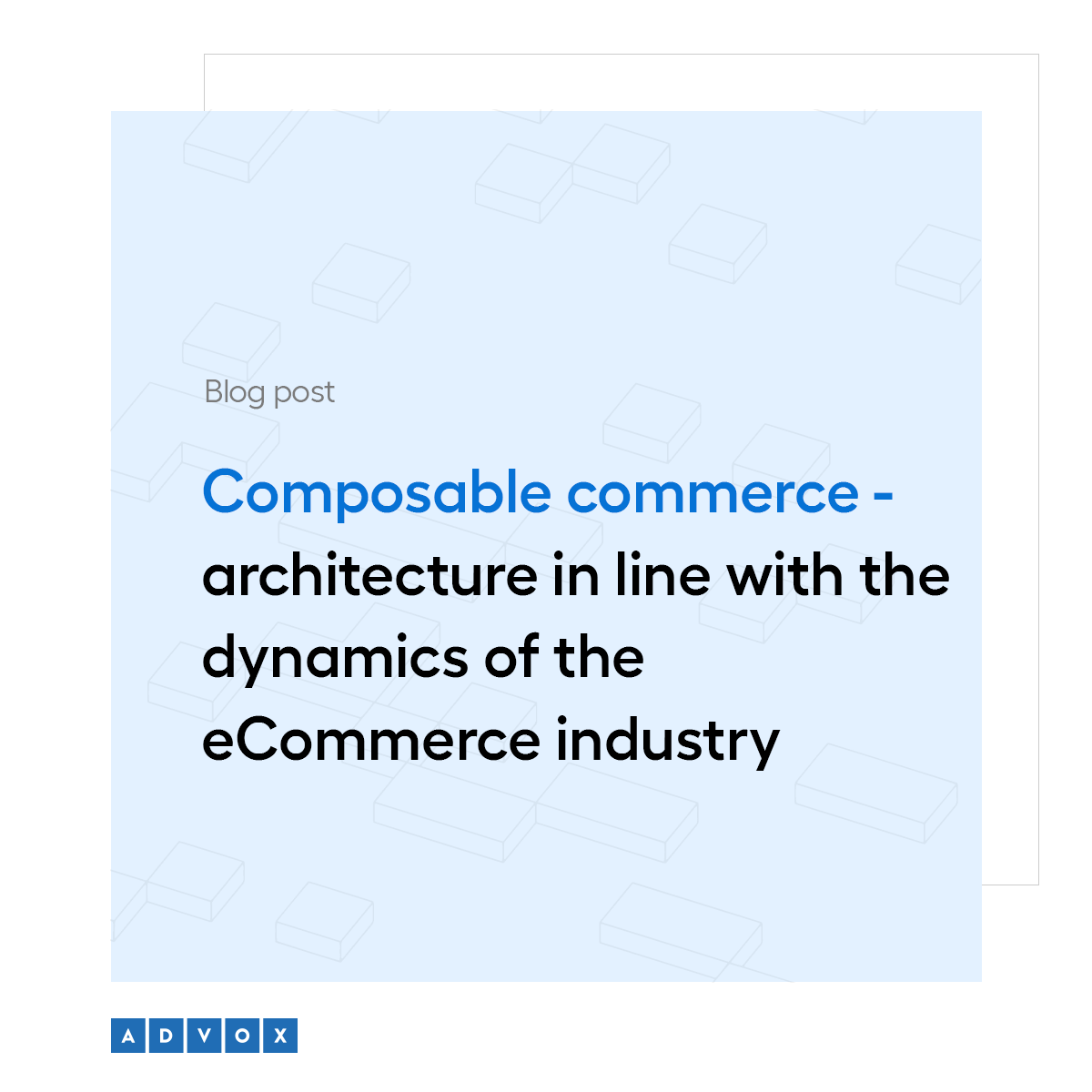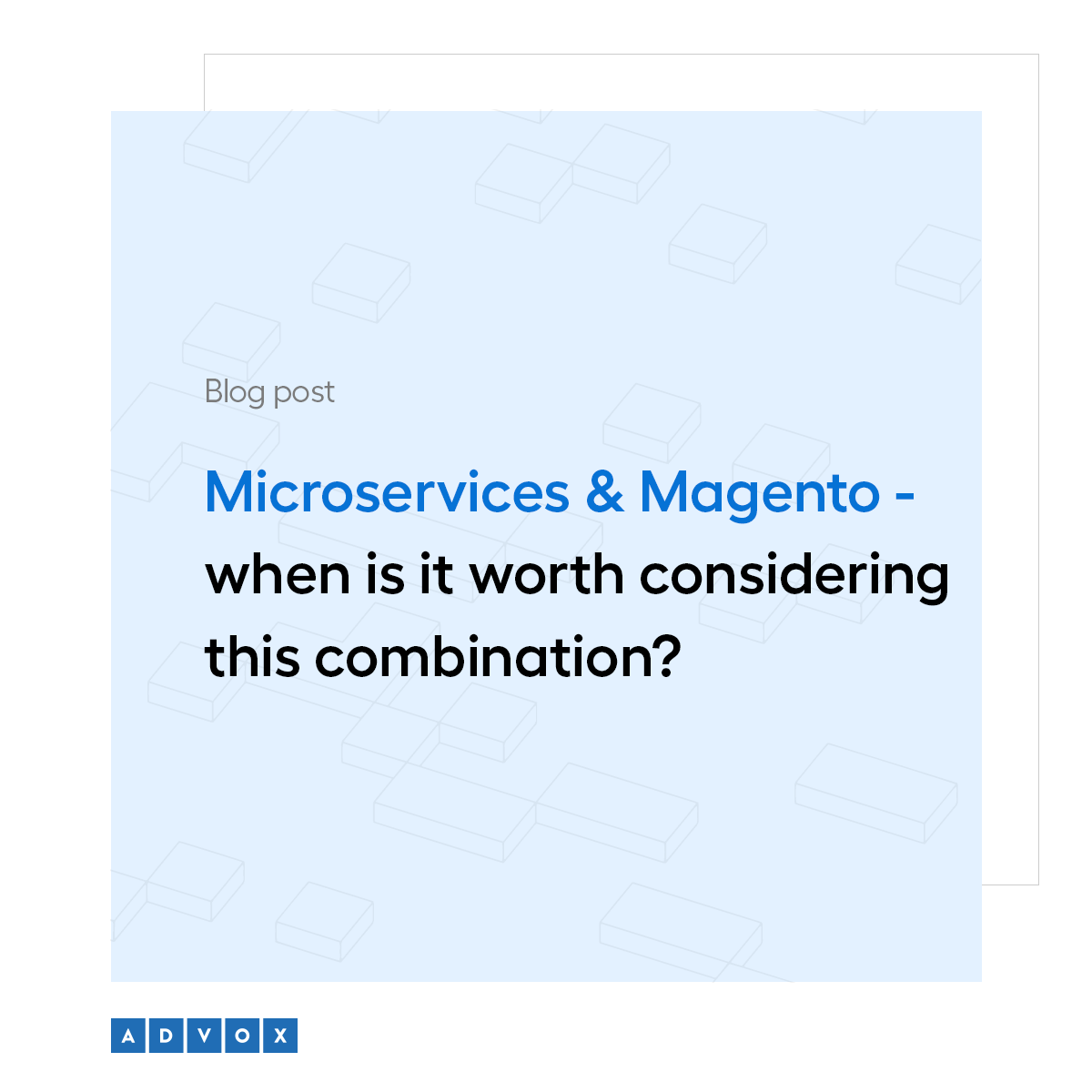Microservices or monolith - which architecture will work for your eCommerce project?
Agile methodologies reign supreme not only in the execution of projects in the IT industry (approaches known as Agile or Scrum), but they are also becoming more common in the topic of building an online store architecture. Companies in various industries are increasingly choosing to move away from the traditional monolith to a system built on a microservices architecture. The choice of eCommerce architecture is an important business decision, which is marked by a number of consequences for the future. Therefore, it is worth considering from the very beginning which solution - microservices or a monolith with a modular structure - will be best just for your online store.
Why is the choice of architecture so important?
When you make any business decision, you think both about what results it will bring in the future and what it will allow you to protect yourself from. The situation is no different when it comes to choosing the architecture underpinning your online store. Appropriately adjusting it to the specifics of your company, the way you operate in your chosen industry or, most importantly, your development plans, is a way to protect yourself from a potential, possibly costly and sometimes very time-consuming process of migration to another architecture model from the very beginning.
Of course, it's not that a migration will always consume a lot of time and money - it all depends on the size of the business, the quality of the existing code, modularity or other factors. However, the fact is that both microservices and monoliths have their advantages and disadvantages, which means that you shouldn't always follow the buzzword and decide on the most popular solution of the moment, and on the other hand - rigidly stick to traditional choices. A better option is to think carefully and discuss the choice of online store architecture with the chosen software house.
Microservices in an eCommerce project - basically what?
The simplest definition of microservices assumes that they are independent components (a.k.a. modules, applications, processes) of small size that allow working on individual elements in an online store without interfering with the architecture of the entire system. Each of these components is responsible for the implementation of a different functionality or service (e.g. payments, orders, product information management) and has its own database, and their efficient interaction or exchange of data is possible, for example, through an API connection.
What does this mean in practice? Thanks to the use of micorserives, individual parts of an eCommerce system can be designed and implemented independently of each other - including by other development teams, which can use different languages and technologies depending on the component. Thanks to such a solution, we are not limited to one or a few technologies, but can use the full catalog (of course, ensuring that it fits the needs of the project).
Such a way of designing online stores is in line with the headless eCommerce (as well as composable commerce) approach assuming development and modification of the system within individual components, without interfering with the others. The independence of the frontend from the backend translates into greater flexibility in implementing new solutions, which allows you to take care of a better user experience for the online store.
Microservices - the answer to the demands of digital business
Giving up a rigid way of designing an eCommerce platform translates into a number of benefits for online store owners. First and foremost is the ability to scale the business according to development needs and the related option of continuous development - microservices allow updates or upgrades to be made frequently. Thus, it is also possible to regularly test proposed solutions.
A microservices architecture also provides the opportunity for individual components to use differentiated languages and technologies, which is not possible with a traditional monolith. In this way, care can be taken to select the best solution depending on the customer's needs and project requirements in specific areas.
What's more, microservices:
- increase the security of the online store by disconnecting certain functions - the lack of relationality reduces the chance of a critical failure occurring that completely shuts down the operation of our online store,
- speed up the deployment process (shorten the production cycle) and the operation of the store,
- reduce technology debt that could block the company's growth (make it easier to implement new technologies),
- increase the stability of the system.
Putting together all these benefits associated with the use of microservices architecture, it should be said that this solution allows you to increase efficiency during the process of developing online stores. However, the requirement for such a situation is to take appropriate DevOps (eCommerce maintenance) actions.
Do microservices have any disadvantages?
When discussing the benefits associated with a particular solution, one cannot also fail to mention the disadvantages and the resulting risks to the project, which one should also be aware of. First of all, the use of distributed architecture increases the complexity of the project (due to the need to implement a mechanism for communication between the various components), which translates into higher development and maintenance costs for the system. What's more, it is also more difficult to make changes that are intended to involve several processes, as it is necessary to work separately within each autonomous element. As a result, the eCommerce development process can become significantly longer.
The disadvantages of microservices should not be forgotten - however, the mentioned disadvantages of this solution do not mean that for some projects it will not be a more optimal option than using a monolithic architecture.
Can monolithic architecture win over microservices?
While microservices include independently operating elements, communicating, for example, via APIs, within a monolith all elements are placed in a single database, which is the result of the hard work of a single development team. By linking all processes, the deployment process does not take long, and debugging and testing comes easier. On the other hand - implementing changes in a monolith means affecting the entire code, which, as a consequence, can make a single bug that appears disrupt the functioning of the entire online store. It is this feature that is used as the most important disadvantage of monolithic architecture, hindering the functioning of the system when it becomes too large and the needs in terms of scalability increase.
Distributed versus monolithic construction - a comparison
Microservices or monolith - when looking for an answer to this question, we must first of all consider the needs of the business. It is pointed out that a monolith will work great among companies that are just starting out and do not quite know themselves how they will grow. If our system is to handle a single process on a not very large scale, such a solution should work best. On the other hand, if we set our sights on such goals as business scalability requiring flexibility in system construction, we should definitely direct our attention towards microservices providing autonomous development of individual components. It is also worth remembering that it is possible to migrate to a different architecture (all or part of the elements, depending on your needs), but this can be an extremely time-consuming and expensive process.
A summary of the most important features of monolithic and microservices architectures is provided below:
| Microservices | Monolithic architecture |
|---|---|
| solution for companies in need of the ability to quickly implement changes and flexibility | solution good for business startups with small needs |
| upgrade of individual components | upgrade of the entire system |
| increased scalability | limited scalability |
| high level of system complexity | lower level of system complexity |
| rapid implementation of changes | slower implementation of changes |
| flexibility in terms of technology | lack of flexibility in terms of technology |
| errors occurring in specific areas | failures affecting the entire system |
Microservices - is it already the standard in IT?
Microservices aren't the buzzword of 2022, as they've been in use for a few years now, but there's no denying that they're still a hot topic. They are taking by storm the attention of the IT community, which for more than 20 years used only monolithic solutions. In the 21st century, where the needs of businesses and the demands of customers are changing rapidly and new technologies are constantly evolving, a flexible approach to the design of eCommerce platforms is simply becoming the standard. Looking at the benefits of using microservices, such a situation should not surprise anyone - in the technology race at the moment, there is no solution better suited to the pace of changes taking place.
However, it should not be forgotten that microservices are not an ideal solution for every project. Each time, the selected software house should analyze which architecture will best meet the needs of a particular business: monolith or microservices, or maybe a hybrid of the two (yes, this is also possible!).
It's like - will you check which solution will be perfect for your project?







